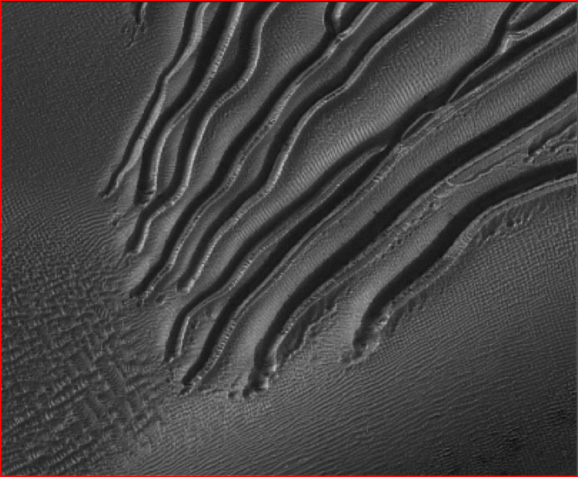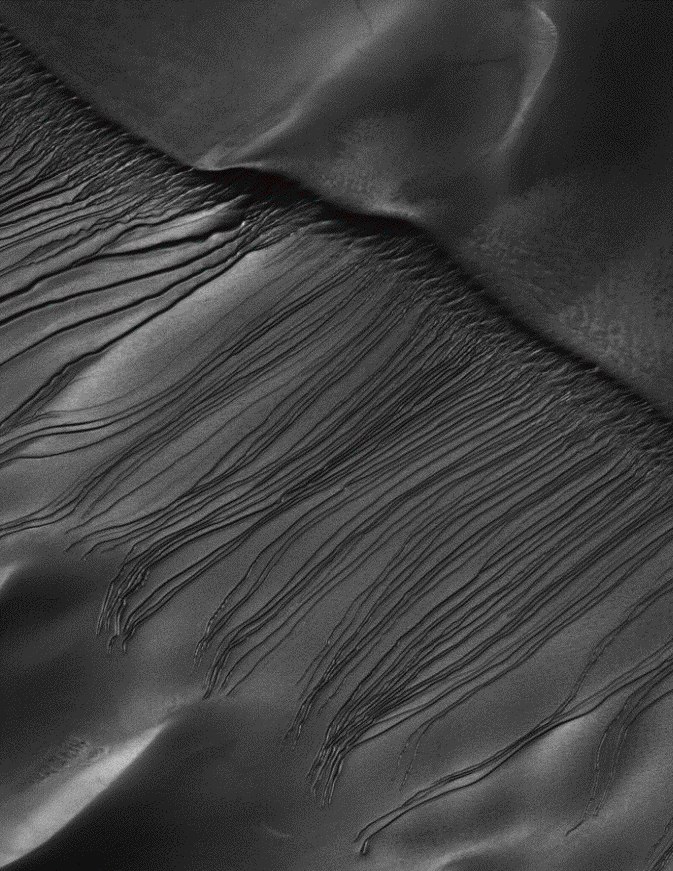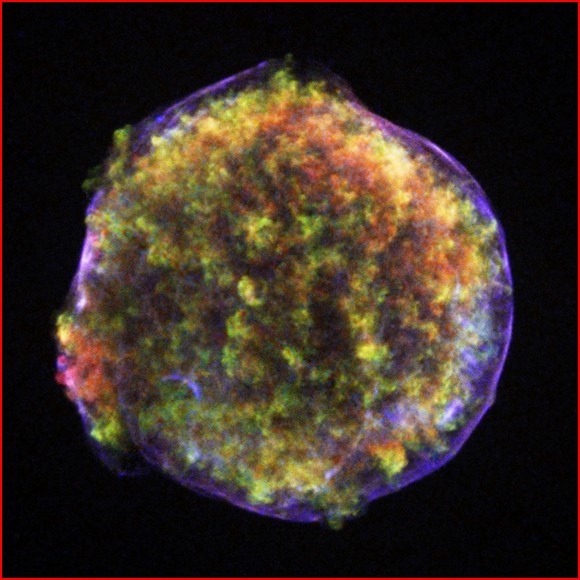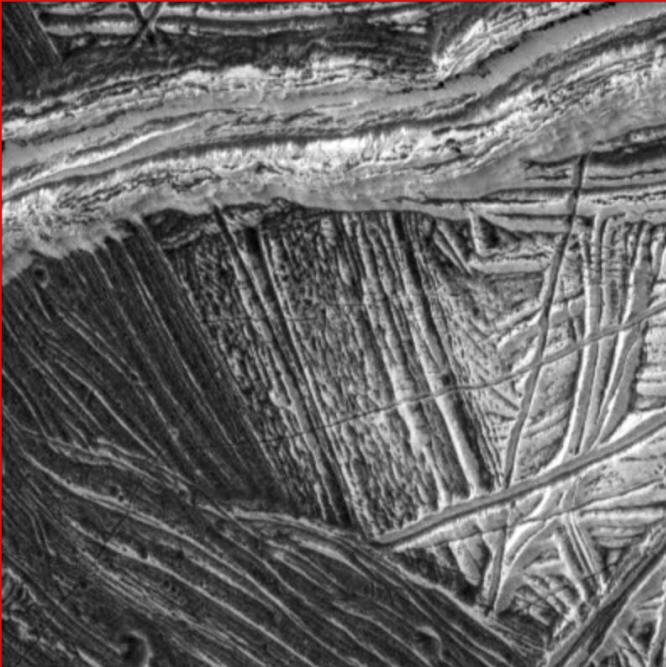
The image shown here is just a small segment of a very large HiRISE image of the
mysterious channels running down a “sand dune” in Russell Crater on Mars.
Posted on 02/23/2008 2:42:58 AM PST by Swordmaker

Feb 12, 2008
The "Gullies" of Russell Crater on Mars(2)Thanks to a recent high-resolution image taken by the HiRISE instrument, it is now clear that conventional “explanations” of the Russell Crater channels have failed. More alive than ever: the electrical interpretation.
The most recent and highest-resolution image of the ravines of Russell Crater (the subject of our Picture of the Day for May 14, 2007) are now in. For a critical observer, a close-up look at the formations should eliminate once and for all the idea that these “gullies” were created by fluid erosion. The huge HiRISE image can be accessed selectively by zooming in on any region.
The HiRISE image provides stunning new support for an electrical interpretation. Channels cut by electric discharge machining will often produce associated non-random cratering and crater chains, now revealed by this latest image. Though the ravines all run downhill, the higher resolution images show that they do not consistently follow topography in the fashion of fluid flow. In electrical terms, that is not surprising. The channels reveal no breeches of levee walls and no outflow at their termination. Within the channels themselves, no evidence can be found of sediment or debris being carried along by fluid. Many of the channels terminate in cleanly cut craters.
The “fishbone” formations below the channels find counterparts in lightning scars (as illustrated in a forthcoming TPOD). Finely cut transverse grooves along the channel walls are diagnostic of the filamentary coronas of electric arcs. The miniature, patterned “dunes” on the vastly larger “dune” are diagnostic of electrostatic sculpting. Dark spotting and darkened nodules scattered about the region point directly to surface effects of positively charged particle beams in the laboratory. Indeed, it is no exaggeration to say that every defining feature of the Russell Crater anomalies, though challenging standard theory, has an undeniable analog in electric discharge scarring.
Of course, these considerations are not on the mind of the specialists analyzing the image, because they are still bound by the “electrically neutral solar system.” Here is what the HiRISE team has to say about the dramatically enhanced view of the ravines:
“Hundreds of enigmatic small channels are seen to carve into the slopes of these dark sand dunes lying within Russell Crater on Mars. These features were previously identified as gullies in images from the Mars Orbiter Camera (MOC) on Mars Global Surveyor, but the higher resolution HiRISE image brings out many new details and mysteries.” And yet, immediately after this acknowledgment an imprisoning theoretical assumption rears its head. “The channels extend from near the top of the dunes to their bases, indicating that some fluid material carved into the sand. The channels commonly begin as smaller tributaries joined together, suggesting several sources of fluid."
It seems that obsolete assumptions still condition today’s scientific observations, so that in the case at hand everything remains an anomaly: “Distinct dark spots are located near where the channels seem to originate. Several channels appear to originate at alcoves. Several of these channels have sinuous middle reaches while others are straighter. Further down slope, some channel edges appear elevated above the surrounding terrain, particularly in the lower reaches. The channels seem to terminate abruptly, with no deposition of material, unlike at the bases of some other gullies on Mars that are not on dunes.”
It is a tragedy that planetary scientists, working with stunning technological achievements, are constrained from seeing what is before them. The authors of the HiRISE page write--
“One hypothesis for the origin of the channels, which has previously been proposed by the MOC team, is that CO2 (or maybe H2O) frost is deposited on the dunes in shadows or at night. Some frost may also be incorporated into the internal parts of the dunes due to natural avalanching. When the frost is eventually heated by sunlight, rapid sublimation triggers an avalanche of fluidized sand, forming a gully. HiRISE will continue to target small channel features such as these and may return to search for any changes over time.”
Browse the massive HiRISE image for yourself. Do you see evidence of avalanching? We can see none--though across every inch of the image we do see the patterns of electrical discharge.But there is much more evidence to consider. If electrical activity created the ravines under discussion, it is highly unlikely that the effects would be limited to these particular anomalies. What can the Russell Crater dunes reveal to us about the pervasive enigmas lying farther to the south, including the mystery of the Martian spiders? (See stories here, here and here.)
Electrical events occurring today on Mars may indeed change forever our outdated ideas about planetary evolution.
___________________________________________________________________________

May 14, 2007
The “Gullies” of Russell Crater on Mars (1)A bizarre complex of channels, lying on the south-facing bank of a “sand dune” in Russell Crater on Mars, directs our attention to something planetary scientists have long ignored--pervasive electrical activity on the planet.
In recent years much evidence has accumulated to suggest that electrical events unknown to mainstream science are “business as usual” on Mars. We have recently discussed outbursts of massive dust storms mysteriously related to global warming on the planet. We have also cited “impossible” assemblies of tightly packed dust devils feeding the billowing clouds of regional storms.
In this TPOD series on Mars, we intend to show that present electrical activity on the planet is carving surface features of sufficient size to be seen from space. This activity, though incomprehensible in traditional geologic terms, is not just a further validation of the “Electric Universe”; it also offers new lines of evidence that can illuminate the earlier catastrophic history of the planet.
One of the mysteries to be solved lies about 55 degrees south, on an immense “sand dune” in Russell Crater. The channels are fresh and show virtually no deposition of circulating dust from the Martian atmosphere. They remain a mystery, so long as one applies conventional assumptions.
The first enigma presented by the ravines is the surreal appearance of the entire complex--an anomalous but repeated pattern. Numerous “tributary” networks, each a virtual copy of its neighbors, feed sharply defined channels running down the embankment. The bizarre repetition of a single pattern appears to defy all familiar erosional regimes. Fluid flow is typically subject to much more random tributary systems and irregular, non-systematic distribution.
In contrast to normal fluid flow, most of the ravines maintain a consistent width, then terminate abruptly, each traveling roughly the same distance as the others. Each gully presents levees that neither grow nor diminish along their path. No breach of ravine walls is evident. No indication of outflow, typical of liquid flowing down a steep incline, can be seen.
Unusual but recurring patterns standing side by side are a good indication that an unusual answer is called for. In this case, that means an answer outside the rules of random topography and fluid erosion. Recurring patterns are, as well demonstrated in decades of laboratory research, extremely common in plasma discharge behavior. And since plasma discharge appears to be directly involved in generating the dust storm and dust devil activity previously noted, it is certainly reasonable to ask whether these remarkable channels might also find an electrical explanation.
A fascinating counterpart to the Russell Crater gullies occurred in an experiment by Bill Beaty, a nationally distinguished and award-winning electronics hobbyist. He produced a trough in a layer of carbon dioxide “fog” by directing beams of protons at the layer from a human hair about 1/4 inch long. Below is a photo of one of the troughs, revealing a remarkable similarity to the enigmatic Martian ravines, including the “levees” and abrupt termination.But why should we believe that something so far from conventional geologic references as beams of positively charged particles could be responsible for the channels under consideration? There are, in fact, dozens of reasons to consider this possibility--all interconnected and all pointing to something that NASA scientists have yet to take into account--a charged planet moving on a modestly elliptical orbit (significantly more elliptical than Earth’s) within the electric field of the Sun.
Planetary scientists do not understand why the highly filamentary channels of Russell Crater tend to lie on south-facing slopes of massive “dunes.” But this is actually another clue suggesting the electrical nature of the formations. Our data, the primary subject of this TPOD series, suggests that positively charged particles from the Sun are entering the Martian ionosphere and following magnetic field lines to the surface. (NASA scientists are finding that localized magnetic fields are much more prominent in the southern hemisphere than the northern hemisphere.) In the absence of a substantial insulating atmosphere, such ion or proton beams could indeed account for the troughs in the Russell Crater “dune” field.
As we have repeatedly emphasized, a new theory must be judged by its predictive power-- it’s ability to account for things left unexplained by prior theory and its record of success in anticipating discoveries that flatly contradict earlier assumptions or catch “official” science by surprise. Electrical theorists do not consider the standard descriptions of the Russell Crater “gullies” to be plausible. Rather, they have viewed these troughs as a “bundle of predictions” awaiting confirmation. Working from general to specific, the electrical interpretation suggests the following:
• Reliable explanations for atmospheric and geologic events on Mars will come from a practical understanding of electric discharge effects;
• Plasma discharge--from electrostatic sculpting, to particle beam effects and spark machining--is altering the surface of Mars year by year.
• The channels on Russell Crater dunes are not the result of flowing liquid;
• When viewed more closely no evidence of flowing liquid will be found;
• When viewed more closely it will be seen that the channels do not follow topography in the fashion of flowing liquid;
• Since the channels are carved into a smooth surface (i.e., a surface not strewn with boulders and rocky rubble), the immediate surroundings should have preserved more subtle evidence of particle beam activity, electrostatic sculpting, and glassification.
• Cratering in connection with channel formation must be anticipated, particularly at the starting points and terminations of the channels
• The events creating the troughs are almost certainly connected to other enigmatic events in the immediate vicinity and in the larger region of the southern hemisphere;
Our reading of the evidence is readily testable. If that reading is correct, then things happening today on the surface of Mars may well present one of the most promising breakthroughs for the Electric Universe hypothesis. What will happen to planetary science if principles virtually ignored for a century or more emerge as inescapable fact?
Coming May 16, 2007: Russell Crater—the Growing Enigma

If you want on or off the Electric Universe Ping List, Freepmail me.
Clearly ice boulder trails. Ice boulders roll down hill and sublimate in the sun. Next question?
Interesting theory. And the craters at the bottom of each channel are caused by bouncing boulders?
Next question?
Where'd the ice come from?
Giant worm trails? There has to be spice on that planet?
I've got a better question; where would we be in planetary science if these principles had NOT been virtually ignored for a centurty or more?
Breathtaking images, thanks for posting.
They are DUNES..... hiding no doubt Worms of the Spice..
There should be evidence of fulgerites, then, somewhere between the dunes, if electrical discharges are the culprit.
Looks like a ski slope with skiers who can’t carve turns.
Meanwhile
Still game for exploring
http://marsrovers.jpl.nasa.gov/gallery/press/spirit/20080215a.html
Go little Rovers
I already know what they are .... the trails left by Sandworms!
Red Planet’s Ancient Equator Located
Scientific American (online) | April 20, 2005 | Sarah Graham
Posted on 04/24/2005 11:18:25 PM EDT by SunkenCiv
http://www.freerepublic.com/focus/f-chat/1390424/posts
 |
||
| · join · view topics · view or post blog · bookmark · post new topic · | ||
The Electric Universe!!!
I like it. :D
PS, what makes that criss-cross looking area? Looks like fabric, to me, it’s strange...
The extinct Martians had dune buggies. ;’)
Or dirt-skis?
I got to thinking about your theory and decided to check some dimensions. The gullies average about 7 - 8 pixels in width and NASA says that the resolution of the full size image is approximately 3 Meters per Pixel... ergo, the channels are approximately 21 to 24 meters in width... that's some ice bolder...
Not as strange as this pattern from Jupiter's moon Europa...

No known form of geological fractures form this type of pattern...
It has to be the mall parking lot. :D
Disclaimer: Opinions posted on Free Republic are those of the individual posters and do not necessarily represent the opinion of Free Republic or its management. All materials posted herein are protected by copyright law and the exemption for fair use of copyrighted works.